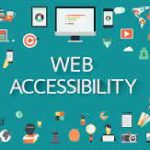In today’s digital ecosystem, one could argue that access to the internet is a fundamental right. 2020 and by the looks of it 2021 has firmly established that digital is the way forward and therefore digital accessibility needs to be part of the business strategy by default and to stay relevant.
What is digital accessibility?
It is the process of making information and digital resources (websites, mobile apps, and other tools & technologies) accessible to all. It is about ensuring users have access to the same information, regardless of any impairments they have.
Most common accessibility issues
When building websites, mobile apps, or digital solutions, organizations are either focused on design or ensuring that the product is optimized across devices. Quite often, digital accessibility is overlooked. But incorporating accessibility features goes a long way in optimizing productivity and ensuring business continuity.
Going remote means people are scattered across the globe, working and/or studying from their homes or other spaces, with limitations in accessing resources. It is therefore imperative that businesses understand the need to create inclusive content. Video-based platforms such as YouTube and Twitch have large communities of blind users. As a result, they have put in the effort to incorporate alt text and detailed labeling of all graphical elements on the videos. It shows they have taken into account the needs of the disabled.
Not just private entities, the government too has done its part. For instance, around 8% of Georgia’s under 65 years of age population is disabled. This prompted the state government to address the issue of accessibility to make information inclusive to all of the state’s residents, regardless of disability.
It decided to revamp its website by incorporating a few simple changes:
-
- Increased the contrast and font size, thereby improving readability
- Improved keyboard-only navigation
- Improved semantic markup, making it easy for people who are blind and others using screen readers to browse the site with ease
Another area where accessibility is crucial is education. Study shows that a mere 16% of students with disabilities have a bachelor’s degree, as against the 35% of those without any disabilities. That apart, 20% of people with one or more disabilities don’t even hold a high school diploma. Moreover, the U.S. Centers for Disease Control and Prevention (CDC) says “1 in 4 adults in the country have some form of disability [includes vision, hearing, cognition and mobility impairments]”. The U.S. Census Bureau has projected that there is likely to be a flip in population with people 65 years and older outnumbering children by 2030. This indicates that disabilities will rise in the next decade.
Offering a seamless experience
According to the National Federation of the Blind, there are nearly 7 million people with a visual disability across the United States. Most of them find the modern web world lacking accessibility. Another study shows that 70% of websites, including many government sites, contain blocks of content that’s unreadable for the visually impaired. The inability to access tax codes, rates, essential forms, and other relevant documents leaves them frustrated, which in turn could lead to an increase in lawsuits against the concerned business or organization.
Businesses need to focus on redefining their offerings and including accessibility as a key element across their website and apps. The average adult uses their mobile device for nearly four hours or more daily. With convenience and easy accessibility being the primary concern, 77% of consumers cite a company valuing their time as the most critical component of providing quality customer service. This does not come as a surprise since users expect a seamless and consistent experience from all businesses and across platforms.
A really simple way to understand digital accessibility is to consider the “caption” option on videos. Captions are used to display the audio content as text on the screen. Individuals who are hearing impaired (partially or completely) can therefore access and understand the content they are viewing. Captions also help others who come from diverse backgrounds, and whose native language is not English. Similarly, alt text is meant for people who have visual impairments and cannot see nor understand the picture on the screen. By adding relevant alt text descriptions to all visual content, businesses can ensure that documents replete with images and illustrations are accessible to people who cannot see.
Similarly, running website audits to check if the uploaded documents comply with accessibility standards and generate reports that can help the business make necessary changes is a good way to ensure better user engagement.
Legal Compliance
Websites, applications, products, and services developed by any brand need to be accessible across platforms. If not, it fails to maintain relevance and is also grounds for legal action. People sent over 265,000 demand letters and filed 2,058 website accessibility lawsuits in 2020. It is now vital for businesses to achieve accessibility to protect themselves from legal action. An intuitive dashboard giving a comprehensive report on the audits carried out, the number of documents available on the site and the ones that have compliance issues is a good place to start.
Digital documents have become a key part of every business. With information readily available across several channels, it is crucial to make web documents accessible for all. Some of the documents that come under this category are:
-
- Microsoft Office documents and files
- PDFs and forms
- Image files and graphic resources
As discussed above, when it comes to document accessibility, there are a few solutions available in the market. One of them is codemantra, a leader in intelligent document processing that offers the accessiblityInsight™ platform to address accessibility issues in documents. The AI-driven platform automates digital document remediation and transforms any document into any desired digital format. Apart from the website audit and compliance reports, codemantra solutions can ensure intelligent content reflow, plus create and edit alt text for all kinds of visuals and graphics.
Bottom line – improved digital accessibility empowers people with disabilities by offering a better user experience, in the process boosting the brand image and limiting legal risks for the concerned business or organization.






